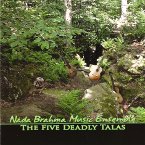Five Deadly Talas
Written by Eric Rasmussen on August 22, 2010.

The Five Deadly Talas
After I began studying classical guitar with Matthew Grasso, I realized we had a mutual interest in Indian classical music. It is an old, beautiful tradition, and very different from what we call classical music in the West. Not long after that, I had a chance to see Matt perform with his group, the Nada Brahma Music Ensemble, an Indian classical fusion group. And not long after that… I joined the group.
I was immediately drawn in by the music, and it was the first time I had heard any type of Indian music played live, fusion or not. I began playing what is known as the drone guitar. The instrument is an unmodified classical guitar, but its unique application earned it a new name. The drone guitarist fulfills two roles: playing the drone notes necessary for Indian classical music (the root and the 5th, in Western terms), and playing the rhythmic pattern for a given raga. I play drone on the first two tracks, and Bill Petaishiski plays drone on the remaining three.
Now that I’ve completed the disclosure portion of the review, let’s get down to business. The newest phase in the life cycle of the Nada Brahma Music Ensemble began when Matt joined forces with Alex Jenkins. Alex plays tabla, a traditional Indian percussion instrument. The group evolved again when Matt conceived the hybrid 25-string Raga Guitar, built by luthier Scott Richter. I could go on for several pages about the guitar alone, so for brevity I’ll instead recommend clicking here if you’d like to learn more.
If you’re familiar with Indian classical music (either North, South, or both), this recording is definitely worth your attention. Although the group still has a “fusion” label, the fusion portion is mostly in the non-traditional instruments and original ragas and talas, but the feeling of the music is still very traditional. Speaking in very general terms, raga is a melodic pattern around which the musicians improvise, and tala is the rhythmic cycle. The recording is called The Five Deadly Talas partly because it’s named after an old Kung Fu classic, The Five Deadly Venoms, but also because the 5 rhythmic cycles are deadly if mishandled. Throughout the CD, the ensemble plays in cycles of 10 ½, 9 ¼, 5 ½, 4 ¾, and 10 beats.
If you aren’t familiar with traditional or fusion Indian music, take some time out of your day to listen to the samples. The familiarity of guitar strings will give you a graceful introduction to the classical music of India. I could fill several posts talking about any single aspect of the performance, including the amazing tabla solos, the effortless cross rhythms, or the melodic depth of the Raga Guitar improvisations, but instead I’ll end with words of strong encouragement: go forth and listen!
Samples are available at CD Baby, Amazon’s MP3 Store, and iTunes.
